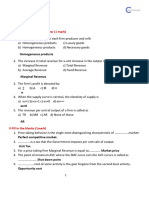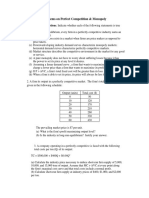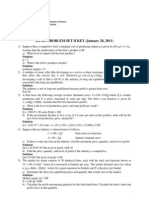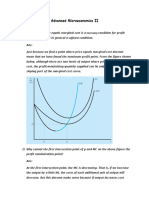PS2 Sol
PS2 Sol
Uploaded by
JOel Suárz RzCopyright:
Available Formats
PS2 Sol
PS2 Sol
Uploaded by
JOel Suárz RzOriginal Title
Copyright
Available Formats
Share this document
Did you find this document useful?
Is this content inappropriate?
Copyright:
Available Formats
PS2 Sol
PS2 Sol
Uploaded by
JOel Suárz RzCopyright:
Available Formats
Econ 461 - Industrial Organization
Stafford, Spring 2001
Solution to Problem Set 2
Exercise 8.3
In a market with annual demand Q = 100 - p, there are two firms A and B that make identical
products. Because their products are identical, if one charges a lower price than the other, all
consumers will want to buy from the lower-priced firm. If they charge the same price, all
consumers are indifferent and end up splitting their purchases about evenly between the two
firms. Marginal cost is constants and there are no capacity constraints. (Assume MC = 10.)
a) What are the single-period Nash equilibrium prices pA and pB?
Nash equilibrium would be for both firms to set p = MC = 10.
b) What prices would maximize the two firms' joint profit?
The monopoly price would maximize the firms' joint prices. A monopoly would set MR = MC.
Since p = 100 - Q, MR = 100 - 2Q. Setting 100 - 2Q = MC gives the monopoly quantity Q = 50 -
1/2 MC = 45 and thus P = 50 + 1/2 MC = 55.
Assume that one firm cannot observe the other's price until after it has set its own price for the
year. Assume further that both firms know that if one undercuts the other, they will revert
forever to the noncooperative behavior you described in (a).
c) If the interest rate is 10%, is one repeated-game Nash equilibrium for both firms to
charge the price you found in part (b)? What is the interest rate is 110%? What is the
highest interest rate at which the joint profit-maximizing price is sustainable?
Charging the monopoly price means getting half of the monopoly profits, or (55 - 10)45/2 =
1012.5. When the interest rate is 10%, the discount rate = 1/(1+r) = 1/1.1 = 0.909. Thus, the
present value of an infinite stream of half of the monopoly profits is equal to 1/(1-)*1,012.5 =
1/0.0909*1012.5 = 11,137.50. Alternatively, if one firm cheated this period they would receive
(54.99 - 10)45 = 2,025. But in the future they would receive 0. Since 11,137.50>2,025, it is a
repeated-game Nash equilibrium for both firms to charge 55 if the interest rate is 10%. If the
interest rate is 110%, then = 1/2.1 = 0.476 and the PV of an infinite stream of half of the
monopoly profits is equal to 1/(1-0.476)*1,012.5 = 1,932.95. In this case, the firm would want to
cheat. As long as 1/(1-)*1,012.5 > 2025, the monopoly price is sustainable. This implies that
1-<1,012.5/2025 or >1-(1,012.5/2025) = .5. Since = 1/(1+r), this implies that 1/(1+r) > .5 or
1+r < 2 which in turn implies that as long as the interest rate is 100% or less, the monopoly price
will be sustainable.
d) Describe qualitatively how your answer to (c) would change if neither firm was certain
that it would be able to detect changes in its rival's price. In particular, what if a price
change is detected with a probability of 0.7 each period after it occurs? (Note: Do not
try to calculate the new equilibria.)
If the probability of being detected is less than one, then a company that cheats may be able to
cheat for more than one period before being caught. This raises the incentive to cheat and
makes sustaining collusion less possible. However, with a probability of detection of 0.7 (which
is relatively high) collusion should still be sustainable.
Return to the situation in part (c) with an interest rate of 10%. But now suppose that the market
for this good is declining. The demand is Q = A - p with A = 100 in the current period, but the
value of A is expected to decline by 10% each year (i.e. to 90 next year, then 81 the following
year, etc.).
e) Now is it a repeated-game Nash equilibrium for both firms to charge the monopoly price
from part (b)?
Declining demand generally makes cooperative pricing more difficult to support. The rate of the
decline acts much like a discount rate on future earnings, since the cost to a firm of "cheating" in
the current period, i.e., the loss of its share of future profits, is less in a declining market.
However, a rate of decline of only 10% will decrease the discount rate to = 1/(1+r) * (1-decline)
= 1/1.1 *(0.9) = 0.909. = 0.818. At this discount rate, the monopoly price can still be sustained.
Exercise 9.4
Consider the following criteria for a good measure of market concentration:
Verify whether the indicies Cn and H satisfy these requirements.
a) Nonambiguity: Given any two different industries, it must be possible to rank
concentration between the two.
Given information as to firm market shares, both indicies will be able to rank concentration
between any two markets.
b) Invariance to scale: A concentration measure ought not to depend on measurement
units.
Both indicies use market share to form the measure of concentration which is a unitless
measure. Thus the indicies are unitless.
c) Transfers: Concentration should increase when a large firm's market share increases at
the expense of a small firm's market share.
Before the transfer, there are two firms with market shares si and sj with si > sj. After the
transfer, firm i has market share (si + x) and firm j has market share (sj - x).
For the Cn, a transfer will not increase concentration if the firms involved in the transfer are in
the top n firms. In other circumstances (e.g., neither firm in the top n after the transfer) there will
also be no increase. Only if firm i is in the top n firms and firm j is not will the transfer increase
the Cn.
For the HHI, any transfer will result in an increase in concentration. Before the transfer, the
contribution of these two firms to the HHI will be si
2
and sj
2
. After the transfer, the contribution of
these two firms to the HHI will be (si+x)
2
+ (sj-x)
2
= si
2
+2six+x
2
+sj
2
-2sjx-x
2
= si
2
+2six+sj
2
-2sjx.
Since si > sj, the contribution of the two firms after the transfer will be larger and thus the HHI
will increase.
d) Monotonicity: Given n identical firms, concentration should be decreasing in n.
If all firms are identical, market share for any one firm is 1/n. For Ck where k is the number of
firms in the concentration ratio, Ck = k/n. The HHI = n*1/n
2
= 1/n. Thus both indicies are
decreasing in n.
e) Cardinality: If we divide each firm into k smaller firms of the same size, then
concentration should decrease in the same proportion.
The Cn will not necessarily decrease by 1/k. Consider the following counter example. There are
two firms each with 30% of the market and two firms each with 10%. All remaining firms have
2% of the market. Thus the C4 is 80%. Divide each existing firm in half. Then the market
shares are 15%, 15%, 15%, 15%, 10%, 10%, 1%1%. Thus the C4 is 60%, which is not half
of the previous C4 score. So cardinality does not hold for concentration ratios.
For the HHI, however, cardinality does hold.
n
i
i
s HHI
1
2
. If each firm is divided into k smaller
firms, then the HHI will become
,
_
,
_
n
i
i
n
i
i
k
s
k
s
k HHI
1
2
1
2
which is 1/k of the original HHI.
Exercise 9.5
Suppose you know only the value of the market shares for the largest m firms in a given
industry. Although you do not possess sufficient information to compute the Herfindahl index,
you can find a lower and an upper bound for its value. How?
You can calculate the lower bound (i.e., lowest possible concentration level) by assuming that in
addition to the m firms there is a very large number of firms each with a very small market
share. With very small market shares, squaring the share makes the terms even smaller, so the
lower bound is just
m
i
i
s HHI
1
2
. For the upper bound, assume that all the remaining firms are
essentially as large as the m-th firm (remember, you know the largest m firms). Then each of
these firms has a market share of sm and there are
m
m
i
i
s s k / 1
1
,
_
of these firms. Then
,
_
+ +
m
i
i m
m
i
i m
m
i
i
s s s k s s HHI
1 1
2 2
1
2
1 * * .
Exercise 10.7
A market consists of two population segments, A and B. An individual in segment A has
demand for your product q = 50 - p. An individual in segment B has demand for your product q
= 120 - 2p. Segment A has 1000 people in it. Segment B has 1200 people in it. Total cost of
producing q units is C = 5000 + 20q.
a) What is total market demand for your product?
Segment A people will not buy if the price is at or above 50. Segment B people will not buy if
the price is at or above 60. Thus the demand for the product is equal to the demand from both
segments if the price is less than 50, equal to the demand from segment if the price is between
50 and 60, and equal to 0 if the price is greater than 60. It can be written as follows:
( ) ( )
( )
60
60 50
50
0
2400 144000 2 120 1200
3400 194000 2 120 1200 50 1000
<
<
'
p if
p and p if
p if
p p
p p p
q
b) Assume that you must charge the same price to both segments. What is the profit-
maximizing price? What are your profits?
MC = 20.
If P > 50 (and less than 60 -- obviously you wouldn't set p > 60), the inverse demand curve is
p = 60 - q/2400 so MR = 60 - q/1200. Setting MR = MC we get 20 = 60 - q/1200. Simplifying
this leads to q = 48,000. At this quantity, p = 40. But if p = 40, then the inverse demand is
actually p = 57.06 - Q/3400 and the MR = 57.06 - q/1700. Setting MR = MC we get 20 = 57.06 -
q/1700. Simplifying leads to q = 63,002 which in turn leads to a profit maximizing price of p =
38.53. Profits are (38.53 - 20) 63,002 - 5000 = 1,166,427.06 - 5000 = 1,116,427.06
c) Imagine now that members of segment A all wear a scarlet "A" on their shirts or blouses
and that you can legally charge different prices to these people. What price do you
charge to the scarlet "A" people? What prices do you charge to those without the scarlet
"A"? What are your profits now?
The market can now be segmented. In Market A, the inverse demand is p =50 - q/1000 so MR
= 50 - q/500. Setting MR = MC, 20 = 50 - q/500. Thus q = 15,000 and p = 35. For Market B,
p = 60 - q/2400 so MR = 60 - q/1200. Setting MR = MC we get 20 = 60 - q/1200. Simplifying
this leads to q = 48,000. At this quantity, p = 40. Profits = (35 - 20)15,000 + (40-20) 48,000 -
5000 = 225,000+960,000 - 5000 = 1,118,000.
Exercise 10.8
Coca-Cola recently announced that it is developing a "smart" vending machine. Such machines
are able to change prices according to the outside temperature.
Suppose for the purposes of this problem that the temperature can be either "high" or "low". On
days of "high" temperature, demand is given by Q = 280 - 2p, where Q is the number of cans of
Coke sold during the day and p is the price per can measured in cents. On days of "low"
temperature, demand is only Q = 160 - 2p. There are an equal number of days with "high" and
"low" temperature. The marginal cost of a can of coke is 20 cents.
a) Suppose that Coca-Cola installs a "smart" vending machine and thus is able to charge
different prices for Coke on "hot" and "cold" days. What price should Coca-Cola charge
on a "hot" day? What price should Coca-Cola charge on a "cold" day?
On a hot day, the inverse demand curve is p = 140 - q/2. Thus MR = 140 - q. Setting MR = MC
we get 20 = 140 - q or q = 120. Thus p = 80. On a cold day the inverse demand curve is p = 80
- q/2 so MR = 80 - q. Setting MR = MC we get 20 = 80 - q or q = 60. Thus p = 50.
b) Alternatively, suppose that Coca-Cola continues to use its normal vending machines
which must be programmed with a fixed price, independent of the weather. Assuming
that Coca-Cola is risk neutral, what is the optimal price for a can of Coke?
Expected demand = (280 - 2p + 160 - 2p)/2 = 220 - 2p. Thus p = 110 - q/2 and MR = 110 - q.
Setting MR = MC we get 20 = 110 - q or q = 90. Thus p = 65.
c) What would Coca-Cola's profits be under constant and weather-variable prices? How
much would Coca-Cola be willing to pay to enable its vending machine to vary prices
with the weather, that is, to have a "smart" vending machine?
Under price discrimination expected profits per day are = ((80 - 20)120 + (50 - 20)60)/2 = 4500
(in cents, or $45). Without price discrimination profits per day (65 - 20)90 = 4050 or $40.50.
Coke will make and extra 4.50 per day per machine if it can develop the smart vending machine
technology.
You might also like
- TATA Steel Financial ModelDocument19 pagesTATA Steel Financial ModelAkshayNo ratings yet
- ECON 315 Practice For FinalDocument9 pagesECON 315 Practice For Finaldimitra triantos0% (1)
- Retail Pro 9 User's Guide: Chapter 10. Recording Sales and ReturnsDocument175 pagesRetail Pro 9 User's Guide: Chapter 10. Recording Sales and ReturnsRyan corominas100% (1)
- 8103-Managerial Economics - Executive MBA - Question PaperDocument4 pages8103-Managerial Economics - Executive MBA - Question Papergaurav jainNo ratings yet
- Managerial Economics Michael Baye Chapter 8 AnswersDocument6 pagesManagerial Economics Michael Baye Chapter 8 Answersneeebbbsy8980% (10)
- Educational Background: Ilham Husni LubisDocument3 pagesEducational Background: Ilham Husni LubisBenz100% (1)
- Đáp Án Tham Khảo Đề 1 KTVMCSDocument5 pagesĐáp Án Tham Khảo Đề 1 KTVMCSnguyenmaiii545No ratings yet
- Answers To Homework 4 Summer 2013Document16 pagesAnswers To Homework 4 Summer 2013Anonymous Q2ATvj8kKtNo ratings yet
- Answers To Homework 5 Spring 2011Document7 pagesAnswers To Homework 5 Spring 2011Achal JainNo ratings yet
- Answers To Summer 2010 Perfect Competition QuestionsDocument7 pagesAnswers To Summer 2010 Perfect Competition QuestionsNikhil Darak100% (1)
- RevisionDocument34 pagesRevisionSs ArNo ratings yet
- Answerstosummer2010perfectcompetitionquestions PDFDocument7 pagesAnswerstosummer2010perfectcompetitionquestions PDFMohammad Javed QuraishiNo ratings yet
- Msci 607: Applied Economics For Management: Q 15 UnitsDocument5 pagesMsci 607: Applied Economics For Management: Q 15 UnitsRonak PatelNo ratings yet
- Tute Sheet Post Mid TermDocument18 pagesTute Sheet Post Mid Termrajeshk_81No ratings yet
- Extra Practice QuestionsDocument4 pagesExtra Practice QuestionsJedNo ratings yet
- End-Of-Chapter Answers Chapter 10 PDFDocument13 pagesEnd-Of-Chapter Answers Chapter 10 PDFSiphoNo ratings yet
- PS5 SolutionsDocument11 pagesPS5 SolutionsyagmurNo ratings yet
- Answers Quiz2 2010Document4 pagesAnswers Quiz2 2010Mohamed Yousif HamadNo ratings yet
- Exam2008 07A KeyDocument15 pagesExam2008 07A KeyRajaaeajasd Gausdj100% (2)
- Econ203 Lab 081Document36 pagesEcon203 Lab 081api-235832666No ratings yet
- Micro Economics Chapter 4Document13 pagesMicro Economics Chapter 4dineshvd2007No ratings yet
- Midterm 2018 Solution ExplanationsDocument10 pagesMidterm 2018 Solution ExplanationsLyn LuongNo ratings yet
- Numericals EconomicsDocument4 pagesNumericals EconomicsHashma KhanNo ratings yet
- Cournot Model With Entry NewDocument8 pagesCournot Model With Entry NewhashimNo ratings yet
- ME Problems PC MonopolyDocument7 pagesME Problems PC MonopolyDevan BhallaNo ratings yet
- 20201221203332YWLEE003Perfect Compyp SolutionDocument19 pages20201221203332YWLEE003Perfect Compyp SolutionDương DươngNo ratings yet
- Answers Homework4Document3 pagesAnswers Homework4anishNo ratings yet
- Đề-vi-mô-csauDocument5 pagesĐề-vi-mô-csaudiepbldahanNo ratings yet
- EconDocument4 pagesEconKianna SabalaNo ratings yet
- q1222 EconnnDocument6 pagesq1222 EconnnSina TempioraryNo ratings yet
- 5-Handout Five-Pure Competition in The Short Run-Chapter EightDocument12 pages5-Handout Five-Pure Competition in The Short Run-Chapter EightImran UmarNo ratings yet
- PQs 5 ADocument4 pagesPQs 5 Aalex-bookNo ratings yet
- CBSE Sample Paper For Class 12 Economics With SolutionsDocument11 pagesCBSE Sample Paper For Class 12 Economics With SolutionsAritroy KunduNo ratings yet
- Answer Set 1: OxfordDocument26 pagesAnswer Set 1: OxfordlowchangsongNo ratings yet
- Microeconomics-Final.: October 8, 2010Document3 pagesMicroeconomics-Final.: October 8, 2010Anu AmruthNo ratings yet
- Exam March 2009 V1 KeyDocument17 pagesExam March 2009 V1 KeyRajaaeajasd GausdjNo ratings yet
- VMCSCHDocument8 pagesVMCSCH2402nguyenlinhNo ratings yet
- NAME - : BRIEFLY Explain How You Would Solve It. Keep The Explanation Brief and To TheDocument5 pagesNAME - : BRIEFLY Explain How You Would Solve It. Keep The Explanation Brief and To TheAlicia KimNo ratings yet
- MN2028 Exam Paper - May 2024Document3 pagesMN2028 Exam Paper - May 2024Araf MuhammdNo ratings yet
- Advanced Microeconomics II Q & ADocument34 pagesAdvanced Microeconomics II Q & AZemichael SeltanNo ratings yet
- Chap 13Document7 pagesChap 13Lê Trung AnhNo ratings yet
- Chapter 8: Answers To Questions and Problems: Managerial Economics and Business Strategy, 5eDocument5 pagesChapter 8: Answers To Questions and Problems: Managerial Economics and Business Strategy, 5eadityaintouch100% (1)
- Chapter 10: Market Power: Monopoly and Monopsony: P MC 1 + 1 EDocument5 pagesChapter 10: Market Power: Monopoly and Monopsony: P MC 1 + 1 EKalyan SaikiaNo ratings yet
- Tutorial 8 - SchemeDocument7 pagesTutorial 8 - SchemeTeo ShengNo ratings yet
- T 7Document4 pagesT 7Diana LarisaNo ratings yet
- EC2066 Microeconomics: Chapter 6: Perfect Competition in A Single Market - Sample Examination QuestionsDocument3 pagesEC2066 Microeconomics: Chapter 6: Perfect Competition in A Single Market - Sample Examination QuestionsolenaNo ratings yet
- Microeconomics - 1 (Understanding Firms) MBA: Mock Exam Maximum Marks: 60 Time: 90 Minutes Weight: 50%Document7 pagesMicroeconomics - 1 (Understanding Firms) MBA: Mock Exam Maximum Marks: 60 Time: 90 Minutes Weight: 50%Pravesh TiwariNo ratings yet
- Chapter 8Document11 pagesChapter 8Kalyani GogoiNo ratings yet
- ECONOMICS Problem SetDocument8 pagesECONOMICS Problem SetnbvnvnvNo ratings yet
- Final Answer KeyDocument6 pagesFinal Answer KeyIanthae Ivy Lubrin DumpitNo ratings yet
- AnswerDocument17 pagesAnswerkooruu22No ratings yet
- Week 2 SolutionsDocument6 pagesWeek 2 SolutionsAnton BochkovNo ratings yet
- Homework 6 AnswersDocument6 pagesHomework 6 AnswersSophia SeoNo ratings yet
- Executive Summary Part 2Document9 pagesExecutive Summary Part 2anantedboard14No ratings yet
- Exercises Tutoring 20230526 SolDocument9 pagesExercises Tutoring 20230526 SolomerogolddNo ratings yet
- PcsDocument4 pagesPcsOntheissues Dot OrgNo ratings yet
- Managerial Economics AssignmentDocument4 pagesManagerial Economics Assignmentvictor230364No ratings yet
- Eco 301 QuestionsDocument16 pagesEco 301 QuestionsSamuel Ato-MensahNo ratings yet
- Student Solutions Manual to Accompany Modern MacroeconomicsFrom EverandStudent Solutions Manual to Accompany Modern MacroeconomicsNo ratings yet
- CPA Review Notes 2019 - BEC (Business Environment Concepts)From EverandCPA Review Notes 2019 - BEC (Business Environment Concepts)Rating: 4 out of 5 stars4/5 (9)
- 8 Filters of Game DesignDocument12 pages8 Filters of Game DesignpnishkaNo ratings yet
- Chapter 19 Auditors Report 2020Document70 pagesChapter 19 Auditors Report 2020Nhi LâmNo ratings yet
- 05 Posting To LedgerDocument2 pages05 Posting To LedgerTrisha Mae BrazaNo ratings yet
- Chap 13 Econ 201Document12 pagesChap 13 Econ 201rsj4No ratings yet
- Requires A Completely Different Mindset To Grow. So Taking Off The Marico Hat Off Kaya and Unshackling It From The Marico Is The Right Thing To DoDocument14 pagesRequires A Completely Different Mindset To Grow. So Taking Off The Marico Hat Off Kaya and Unshackling It From The Marico Is The Right Thing To DoShivani ShahNo ratings yet
- IJRPR15453Document7 pagesIJRPR15453vishnu varadhananNo ratings yet
- Basic AccountingDocument16 pagesBasic AccountingronnelNo ratings yet
- Financial and Economic Texts' Translation - 2 PGDocument2 pagesFinancial and Economic Texts' Translation - 2 PGbia1209No ratings yet
- Market IntegrationDocument34 pagesMarket IntegrationClarynce MojadoNo ratings yet
- Business Development Associate 5.29.52 PMDocument2 pagesBusiness Development Associate 5.29.52 PMRegan DcunhaNo ratings yet
- Jainson Hardware: Name: Diana Dsouza Roll No. 1313Document2 pagesJainson Hardware: Name: Diana Dsouza Roll No. 1313Diana D'souzaNo ratings yet
- Arthur - ResumeDocument1 pageArthur - ResumeAlex MaleubreNo ratings yet
- Network PlanningDocument59 pagesNetwork PlanningVignesh ManickamNo ratings yet
- Accounting SyllabusDocument1 pageAccounting SyllabusJonathan AddoNo ratings yet
- 12 Analyze The Different Operations ManagementDocument24 pages12 Analyze The Different Operations ManagementJayanth KumarNo ratings yet
- Accounting Homework Chapter 5Document3 pagesAccounting Homework Chapter 5Kimberly Garmon100% (2)
- Assignment - Share-Based Compensation - October 19, 2024Document3 pagesAssignment - Share-Based Compensation - October 19, 2024Princess TapangNo ratings yet
- Finman MidtermDocument2 pagesFinman MidtermLinbert MalinaoNo ratings yet
- Strategic Management: Theory & Cases: An Integrated Approach. ISBN 1305502272, 978-1305502277Document23 pagesStrategic Management: Theory & Cases: An Integrated Approach. ISBN 1305502272, 978-1305502277clariennisrux100% (9)
- Guest Management Day Closing. Call Management, Internet BillingDocument2 pagesGuest Management Day Closing. Call Management, Internet Billingalakh400No ratings yet
- bài tập tổng hợp 1Document10 pagesbài tập tổng hợp 1Hoàng Bảo TrâmNo ratings yet
- ITM Course Outline - Spring 2024Document9 pagesITM Course Outline - Spring 2024Ashar ZiaNo ratings yet
- 1 s2.0 S2214785322018284 MainDocument6 pages1 s2.0 S2214785322018284 MainjihanNo ratings yet
- CHAPTER 3 Multichannel and Omnichannel RetailingDocument23 pagesCHAPTER 3 Multichannel and Omnichannel RetailingRoxan CalisasNo ratings yet
- Case Study 2Document6 pagesCase Study 2awieNo ratings yet
- Curriculum Vitae: Abhishek ChaudharyDocument4 pagesCurriculum Vitae: Abhishek ChaudharyvikasNo ratings yet
- Oracle Managed Cloud Services Global Price ListDocument18 pagesOracle Managed Cloud Services Global Price ListnikhilNo ratings yet

























































































